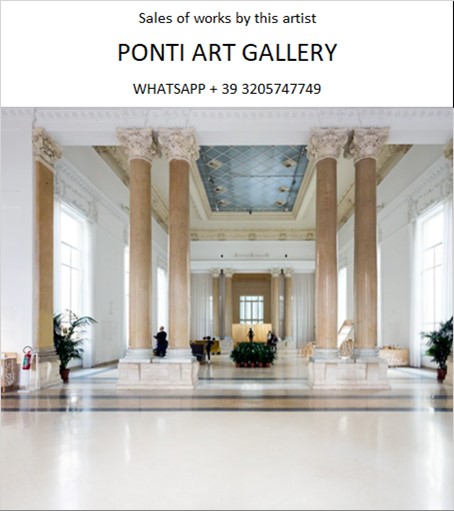Ponti Art Gallery is interested in buying and selling works
of art by this artist.

Gene Davis Biography
Gene Davis was an American painter, celebrated for his vibrant and rhythmic stripe paintings that became emblematic of the Color Field movement and the Washington Color School. Born on August 22, 1920, in Washington, D.C., Davis's life and career were deeply intertwined with the city where he spent nearly all his life.
Before embarking on his artistic journey, Davis had a successful career as a journalist. He worked as a sportswriter, covering local teams and the Washington Football Team. His journalistic endeavors also led him to cover the Roosevelt and Truman presidential administrations, and he was known to have been President Truman's partner in poker games. Davis's first art studio was modestly situated in his apartment on Scott Circle, and later he worked out of a studio on Pennsylvania Avenue.
Davis's interest in art was piqued at an early age. As a child, he would send his drawings to the Washington Post's "Children's Page," and at the age of eight or nine, he won a $1 prize for his work, which he described as the thrill of a lifetime. He took a drawing course in high school, but there was a significant hiatus before he returned to the visual arts. It wasn't until 1949, at the age of 29, that Davis began to paint.
In the 1950s, Davis, along with Kenneth Noland and Morris Louis, formed a small group of painters who would later be recognized as the Washington Color School. This group of artists was known for their innovative use of color and abstract compositions. Davis was particularly influenced by the works he studied in the Phillips Collection, including those by Pierre Bonnard and Paul Klee, and the conversations he had with local artist Jacob Kainen and a meeting with Willem de Kooning.
Davis's early work was characterized by a variety of styles, including Abstract Expressionism, Neo-Dada, and Proto-Pop. However, he is best known for his acrylic paintings of colorful vertical stripes, which he began to paint in 1958. His first solo exhibition of drawings took place at the Dupont Theater Gallery in 1952, and his first exhibition of paintings was at Catholic University in 1953. A decade later, he participated in the "Washington Color Painters" exhibit at the Washington Gallery of Modern Art, which traveled across the U.S. and solidified the Washington Color School as a significant movement.
Davis's stripe paintings are known for their simplicity and directness, allowing viewers to focus on the color itself. He varied the width of the stripes and their color to create complex rhythms and sequences. Davis often compared his method to jazz improvisation, describing his approach to painting as 'playing by eye.' He did not prepare his color combinations in advance but improvised each work, adding one stripe at a time, never certain of the problems or possibilities each new element would pose.
Throughout his career, Davis experimented with various formats and media, including collages, modular compositions, and even large-scale outdoor street paintings. In 1972, he created Franklin's Footpath, which was at the time the world's largest artwork, by painting colorful stripes on the street in front of the Philadelphia Museum of Art. His "micro-paintings," on the other hand, were as small as 3/8 of an inch square.
Davis's work is characterized by a sense of spontaneity and improvisation, despite their calculated appearance. He did not base his stripe works on conscious use of theories or formulas. Instead, he preferred to experiment with color intervals, creating rhythmic effects within his compositions. His works range in scale from minuscule micro-paintings to mammoth outdoor street paintings, and he worked in various media, including video tapes and neon.
Davis taught at the Corcoran School of Art in Washington, D.C., and at various other institutions. He was a self-taught artist who considered his nonacademic background a blessing, as it freed him from the limitations of a traditional art school orientation. His unorthodox approach to art-making was balanced by a sense of seriousness, whimsy, and unpredictability.
Gene Davis passed away on April 6, 1985, in Washington, D.C. His legacy continues to be celebrated, and his works are included in the collections of major institutions such as the Walker Art Center in Minneapolis and the Guggenheim Museum in New York. Davis's contributions to American painting were invaluable in establishing Washington, D.C., as a center of contemporary art and in the broader color abstraction movement that first achieved prominence in the mid-twentieth century.
Gene Davis Quotes and Sales of
Works
Ponti Art Gallery selects and deals with paintings by the
artist. Upon request, we provide free estimates and
evaluations, communicate prices, quotations, and current
market values.
If you are interested in BUYING or SELLING works by the
artist, contact us immediately.
If you wish to sell or receive an evaluation of the
works:
Send us a frontal photo of the painting, one of the back,
and one of the signature. Also, indicate the dimensions of
the work. Inform us about the purchase origin of the work
and any kind of available documentation (purchase
receipts, certificates of authenticity, publications). One
of our operators will respond to you on the same day. We
guarantee maximum confidentiality and extreme
professionalism.
If you wish to purchase works by the painter: Contact us
and let us know your request. We will inform you about the
available works. We also offer the possibility to
subscribe to our NEWSLETTER, through which you will be
informed at the beginning of each month about the latest
acquisitions of the art gallery.
You can send us pictures of the work:
